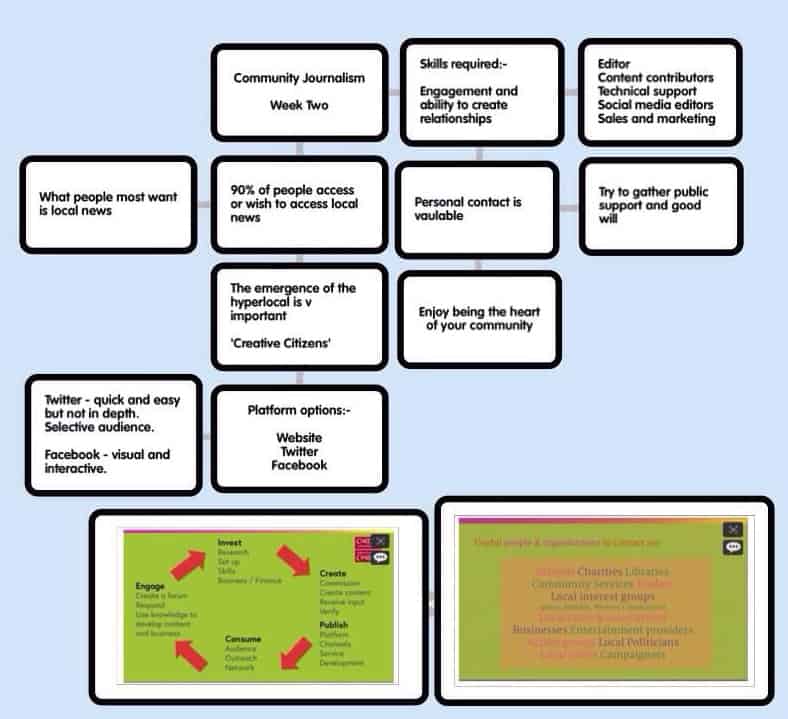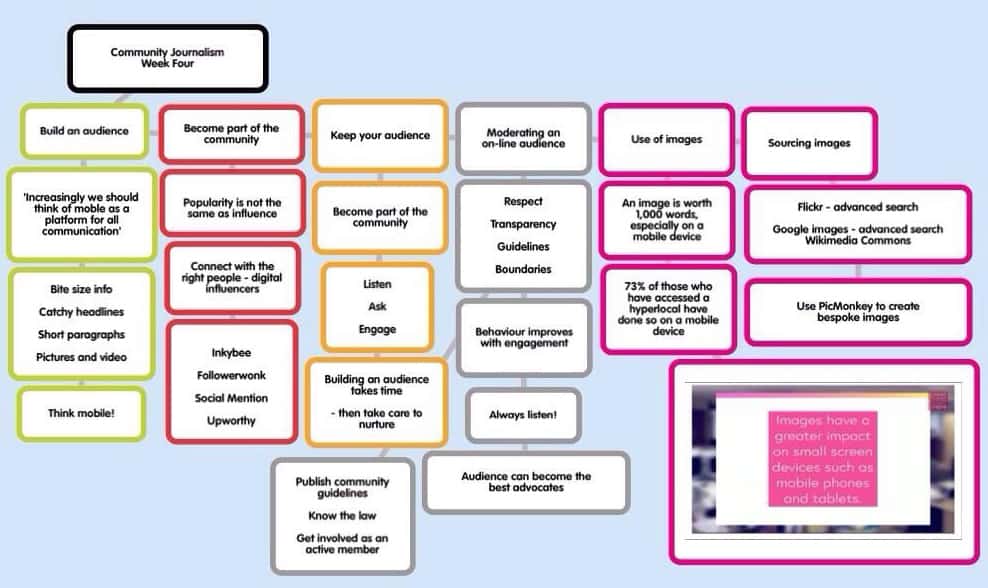Course Review: Community Journalism: Digital and Social Media offered by Cardiff University
Learn the art of hyperlocal journalism to gain an audience and engage with your community.
Review by Sarah Nicholson. Took the course? Write your own review here.
As the headteacher’s PA at Devonport High School for Boys in Plymouth, UK, my roles include writing and editing our newsletters and developing our social media channels. I haven’t had any formal journalism experience or training but have always enjoyed writing and desktop publishing.
The main attraction for me was the chance to hear directly from the leading academic staff in my chosen subject.
I was challenged to sign up for a MOOC at the same time as I was thinking about how to develop the school’s online presence and the content of the Community Journalism course seemed to offer ideas on how to take this forward. I wasn’t sure what to expect but felt confident that this would provide an excellent introduction. The main attraction for me was the chance to hear directly from the leading academic staff in my chosen subject.
UNIVERSITY
This MOOC is provided by the Centre for Community Journalism (C4CJ) based at Cardiff University. The Centre conducts research and offers networking, information and training for hyperlocal and community journalists building on expertise developed at the leading School of Journalism, Media and Cultural Studies.
LEADERS
I was hugely impressed with the credentials and expertise of the team leaders and course facilitators including the following members of staff:
Professor Richard Sambrook
Richard Sambrook is Professor of Journalism and Director of the Centre for Journalism which undertakes postgraduate vocational training. He is a former Director of Global News at the BBC where he worked as a journalist for 30 years as a producer, editor and manager. He has been a Visiting Fellow at the Reuters Institute for the Study of Journalism at Oxford University where he undertook research into the future of international newsgathering and the place of impartiality and objectivity in the digital world.
Sara Moseley, Distinguished Visiting Fellow
Sara leads the Community Journalism Engagement Project as well as working on the overall strategy, funding support and research output of the Centre for Community Journalism. Sara is on secondment from the Welsh Government, where, as Director of Communications, she led on all aspects of press and media, digital and publicity for three administrations.
Emma Meese, Centre Manager
Emma manages the Centre for Community Journalism, giving community journalists access to the highest standard of training in digital and social media. Emma also speaks at a number of conferences and events, including the Social Media Conference for Wales.
Hannah Scarbrough, Communications and Project Officer
Hannah’s role involves administering the work of the Centre for Community Journalism and reporting on its progress through its website and social media channels.
PREREQUISITES
There are no real prerequisites for this course other than an interest in writing and an opportunity to publish work online which will give focus and help develop skills.
THE COURSE
Week one: “What people most want is news about their community”
Introduced the concept of community journalism and explained why the publication of traditional newspapers is in decline. Understanding the audience and ensuring accuracy were key messages this week.
Week two: “Enjoy being the heart of your community”
Considered the skills required in setting up a community news site and the platform options. The use of Twitter and Facebook were outlined.
Week three: “Authenticity cuts through the noise”
This week the course covered the ‘who, what, why, where, and when’ of writing a good story. Finding a voice and brand was emphasized and the importance of analytics was covered. Statistics are good but the user must look at what is being measured.
Week four: “Increasingly we should think of mobile as a platform for all communication”
Looked at how to keep an audience and also the use of images.
Week five: “Create a sense of community”
Looked at measuring success and considered various business models. Sustainability is important.
All five weeks gave a good insight into both theory and practice. Law and ethics were also touched upon.
EFFORT
The course introduction advises participants to spend around four hours a week over a five week period and I found this was an accurate reflection of the time required to complete the tasks. If I had extra time, I would have been more involved in the on-line blogs and comments.
COMMUNITY
It was useful to follow the Twitter hashtag to see and hear other learners’ thoughts. I also shared a summary each week which helped me to consolidate my own learning. Although I didn’t follow all the blogs and comments each week, I could see the course directors were responding to other learners’ posts.
It was useful to follow the Twitter hashtag to see and hear other learners’ thoughts.
WRAP-UP
Most useful for me were the sections on engaging and serving communities, building and nurturing an audience, the use of images and how to write a good story. Other learners may find that the theory and legal aspects of the course are more useful in their situation. Also very interesting for me was the “Think Mobile” section on considering the use of mobiles and tablets as a platform for communication. We know from looking at the school’s website statistics that this is a growing area for us.
I’ve definitely used what I have learned, as during the last year I’ve been involved in developing a new school website and built an audience for our weekly online newsletter called the Head’s Blog which has grown to over 1,000 views per week.
The practical advice on writing, sharing news stories and using images and photos continues to be very useful. Equally valuable is the guidance on nurturing and maintaining an audience. Developing a brand and finding a voice has been important for Devonport High School for Boys.
The thoughts shared in week three about ensuring authenticity have been key to the success and development of our culture.
I’ve found that students and families are happy to engage and contribute to our social media strands when they can rely on the accuracy and integrity of stories and images. This has helped to develop the positive perception of our school and community.
Class Central is looking for reviewers and regular contributors. If you’ve ever finished a MOOC and want to write a critique to help future students considering taking that course, we want to hear from you. Drop us a mail.











